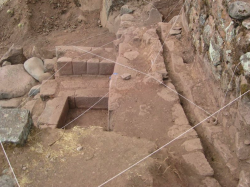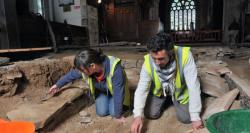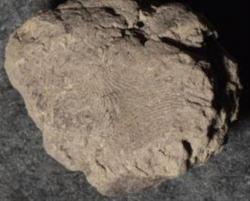INSTITUT SUPERIEUR D'ANTHROPOLOGIE
INSTITUTE OF ANTHROPOLOGY
ONLINE COURSES / COURS A DISTANCE
WINTER TERM : JANUARY 2015
REGISTER NOW
PEROU –  Incahuasi - Archaeologists working upon the Incahuasi (or Inka Wasi) site recently made an exciting discovery when they came across a carved stone with 13 angles. Peru’s Ministry of Culture reports that the stones belong to a hydraulic system. Researchers however are not certain if the stones were used for agriculture or for ritual purposes. Surrounded by a rocky hill and a small stream, Incas situated in this long ago palace would have received water from what came down the hill and fed into the Viscacha river. Located in the Huaytará district of Huancavelica, the archaeological site takes its name from the Quechua language and can be translated as “Inca house”.Earlier this year, a discovery of quipus was made at Incahuasi as well. A form of record-keeping, a majority of quipus had been destroyed in the 16th century by Spanish conquistadors.
Incahuasi - Archaeologists working upon the Incahuasi (or Inka Wasi) site recently made an exciting discovery when they came across a carved stone with 13 angles. Peru’s Ministry of Culture reports that the stones belong to a hydraulic system. Researchers however are not certain if the stones were used for agriculture or for ritual purposes. Surrounded by a rocky hill and a small stream, Incas situated in this long ago palace would have received water from what came down the hill and fed into the Viscacha river. Located in the Huaytará district of Huancavelica, the archaeological site takes its name from the Quechua language and can be translated as “Inca house”.Earlier this year, a discovery of quipus was made at Incahuasi as well. A form of record-keeping, a majority of quipus had been destroyed in the 16th century by Spanish conquistadors.
http://www.peruthisweek.com/news-stone-with-13-angles-discovered-at-incahuasi-site-104281
IRLANDE –  Youghal - Archaeologists working on a church in Cork have discovered three burial vaults dating back to the 1600s, pottery, and coins from that period and a 300-year-old underground central heating system copied from the Romans. The discoveries have been made at the 1250-built St Mary’s Collegiate Church in Youghal — the longest, constantly used church in the country. Archaeologist Caroline Desmond said they moved onto the site after subsidence was noticed in the aisle. Discoveries show that in the 17th century, Youghal was a far more prosperous town than Cork and had more trade in its port. Excavations began six weeks ago and they discovered vaults underneath the aisle. One vault, dated February 1661, contains the remains of John Luther, an alderman of the town and his wife, Elizabeth. Another vault, dated 1678, contains the remains of one of the Earls of Desmond, John Fitzpatrick. The other vault has yet to be dated and archaeologists don’t as yet know who is interred in it. “We have unearthed some pottery and coins from the 17th century and a fabulous underground central heating system which was modelled on Roman aqua duct system. It dates to the 18th century and boiling water was poured in to provide the heating,” Ms Desmond said.
Youghal - Archaeologists working on a church in Cork have discovered three burial vaults dating back to the 1600s, pottery, and coins from that period and a 300-year-old underground central heating system copied from the Romans. The discoveries have been made at the 1250-built St Mary’s Collegiate Church in Youghal — the longest, constantly used church in the country. Archaeologist Caroline Desmond said they moved onto the site after subsidence was noticed in the aisle. Discoveries show that in the 17th century, Youghal was a far more prosperous town than Cork and had more trade in its port. Excavations began six weeks ago and they discovered vaults underneath the aisle. One vault, dated February 1661, contains the remains of John Luther, an alderman of the town and his wife, Elizabeth. Another vault, dated 1678, contains the remains of one of the Earls of Desmond, John Fitzpatrick. The other vault has yet to be dated and archaeologists don’t as yet know who is interred in it. “We have unearthed some pottery and coins from the 17th century and a fabulous underground central heating system which was modelled on Roman aqua duct system. It dates to the 18th century and boiling water was poured in to provide the heating,” Ms Desmond said.
http://www.irishexaminer.com/ireland/dig-at-church-unearths-burial-vaults-293720.html
TURQUIE –  Çatalhöyük - Excavations at the 10,000-year-old Boncuklu mound have unearthed finger prints on kiln objects. The fingerprints are being examined by Dr. Lori Hager, a specialist on the subject. Works have been continuing on the Boncuklu mound, located in the Central Anatolian province of Konya’s ancient settlement of Çatalhöyük, since 2006. The head of the excavations is Liverpool University Archaeology Department Professor Douglas Baird. The fingerprints have been found on broken, nail-sized objects made in a kiln. The photos of the prints were published on the official website of the Boncuklu mound excavations. Their photos, which were taken with a Reflectance Transformation Imaging (RTI) technique, were then converted into 3D images. Examinations of the kiln pieces will show whether the fingerprints belonged to men, women or children.
Çatalhöyük - Excavations at the 10,000-year-old Boncuklu mound have unearthed finger prints on kiln objects. The fingerprints are being examined by Dr. Lori Hager, a specialist on the subject. Works have been continuing on the Boncuklu mound, located in the Central Anatolian province of Konya’s ancient settlement of Çatalhöyük, since 2006. The head of the excavations is Liverpool University Archaeology Department Professor Douglas Baird. The fingerprints have been found on broken, nail-sized objects made in a kiln. The photos of the prints were published on the official website of the Boncuklu mound excavations. Their photos, which were taken with a Reflectance Transformation Imaging (RTI) technique, were then converted into 3D images. Examinations of the kiln pieces will show whether the fingerprints belonged to men, women or children.
http://www.hurriyetdailynews.com/ancient-fingerprint-found-in-catalhoyuk-.aspx?pageID=238&nid=73446&NewsCatID=375